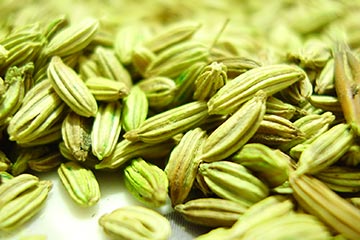
Sana and Sannut
Abu Ubayy ibn Umm Harâm narrated that the Prophet said, "Take the "Sana" and "Sanntt" (as medicines) for in both of them there is healing for every disease except death. "
Explanation of the Hadith
"Sana" is a shrub-like perennial desert plant, which belongs to the leguminaceae family. It grows wild in the desert areas spreading from Mauritania in the west to midAsia in the east. It is planted annually. Its leaves look
'Sannût is a plant, which is said to be either cumin or dill.
Reported by Iman at-Tirmidhi, hadith no. 2163, Ibn Majah, hadith no. 3457 and al-Hakim, hadith no. 4/201.
yellowish whereas the seeds are broad and kidney-shaped. Its scientific name is "Cassia Senna". There are many species of Senna, such as "the Senna of Hijâz", also known as "Makkan Senna", "Senna aschrek" with ovate leaves and are also known as "Cassia senna acutifolia". "Cassia angustifolia" is the scientific name for the Indian Senna, the leaves of which are lanceolate having more pointed leaves at the apex.
Both the dried leaves and pods of Senna are used for medicinal purposes such as in cases of chronic constipation (as laxatives), loss of appetite, indigestion, anemia, hepatitis, bronchitis, liver and spleen diseases and the digestive tract disorders, in addition to some cases of headache and back pain. When brewed with vinegar, it is used for the treatment of cough, hemorrhoids, various skin diseases, hair loss and also for the healing of wounds. When mixed with Sannût, it treats malignant tumors, Allah willing.
Almost two grams of dried leaves and pods are soaked in a glass of water for 12 hours, and then the patient can drink the syrup. Dried Senna can also be ground, mixed with honey and then swallowed.
There are several important organic active ingredients in the leaves and pods of Senna, such as: Glycosides, Hydroxils, kaempferol, isorinamnetin, Calcium oxalate, besides several sitosterol, gelatinous compounds and resins.
As for the "Sannût", it is a wild, aromatic herb, which belongs to the parsley family. It is planted annually in several parts of the world. It has small leaves, non-juxtaposed, and clusters of small white or pink flowers and brownish green fruits with strongly aromatic scent and sharp pungent taste.
Sannût is known as "white cumin", "green cumin" or "dill", and its scientific name is "Cuminum cyminum" or "Anethum graveolnes". Cumin seeds are of the essential spices covered with short fluff and are easily divided in halves. They contain 3-7% volatile oil, in addition to several organic and inorganic components, such as: caffeine, limonene, pinene, dinetene and phellendrene.
Cumin seeds are used as an appetizer, to relieve colic, as a carminative and antispasmodic remedy, in some cases of ophthalmia and neural diseases, insomnia and also in some cancer cases.
Dr. 'Abdul Bâsit Sayyed Muhammad, Professor of Medical Bio-physics at the National Research Center in Cairo, has several studies in this field, especially in treating some malignant tumors, may Allah grant him success.
Each of those two plants, still needs to be studied extensively, each on its own, and in mixtures in various ratios, until we find out the reason for them being mentioned together in one hadîth of the Prophet , who described them as being a cure for all diseases except for death.